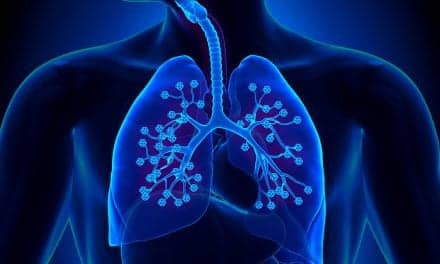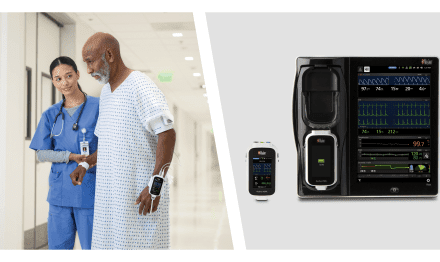Respiratory care in the NICU (neonatal intensive care unit), in collaboration with other medical disciplines, can reduce length of hospital stay and lower risk of long-term disability.
By Phyllis Hanlon
Nearly all newborns run the risk of respiratory difficulties at birth, according to the March of Dimes. Those born prematurely often have breathing problems due to underdeveloped lungs, but full-term babies can also develop respiratory issues from a difficult labor and delivery, birth defects, or infection. Respiratory care in the neonatal intensive care unit (NICU), in collaboration with other medical disciplines, can reduce length of hospital stay and lower risk of long-term disability.

Presenting Diagnoses
Michelle Elias-Ruiz, MD, neonatologist at Cleveland Clinic Children’s Hospital, reported that respiratory distress syndrome (RDS), secondary to surfactant deficiency, is the most common problem in premature babies, while transient tachypnea of the newborn (TTN), pneumonia, and aspiration syndromes are more common in full-term babies.
“Another important category includes extra pulmonary causes of pulmonary failure, like central nervous system (CNS) and neuromuscular disorders. Cardiac malformations and surgical conditions often warrant respiratory support,” she added. Some other conditions to consider, although less common, are genetic defects, such as congenital diaphragmatic hernia (CDH) and congenital pulmonary airway malformation (CPAM).
Risk factors for developing respiratory issues can be divided into antenatal, natal, and post-natal phases, Elias-Ruiz noted. Maternal diabetes and/or exposure to medications may affect the newborn’s ability to transition to life outside the womb. “During the delivery process the baby might encounter birth depression, shoulder dystocia, and birth injuries that may lead to the need for respiratory support,” she said.
First Line of Treatment
Treating a neonate requires understanding of “how a diagnosis presents, the predisposed condition that puts the infant at risk, and how each diagnosis should be treated,” according to Donna Elkins, RRT-NPS, AE-C, clinical specialist in the NICU at Florida Hospital for Children in Orlando. “For example, when a baby presents with bradycardia, this usually has its origin in a respiratory problem,” she said. “In most cases, when the airway or breathing intervention is done, the heart rate will improve.”
The care team at Florida Hospital for Children uses interventions that will minimize damage to premature lung tissue. “Flow controlled and pressure limiting devices, such as Neo-Tees or Neopuffs, are used during delivery resuscitation to prevent lung damage,” Elkins reported. “Noninvasive ventilation, such as NCPAP or NPPV (noninvasive positive pressure ventilation) is preferred to assist ventilation of neonates. Early surfactant replacement therapy can also assist in lung protection. Our rates of bronchopulmonary dysplasia (BPD) have dropped with improved options of NPPV.”
Dave Lockwood, clinical account manager at Hamilton Medical, indicated that there is a lot of discussion and disagreement on what respiratory issues can be adequately supported by noninvasive ventilation as well as what amount of support should be attempted.
“I think one of the biggest challenges, and an area that can still use a lot of improvement, is the infant-ventilator interface. Many of the same issues seen with NIV with adults are encountered with neonates, mainly skin breakdown and minimizing leaks. Another big issue can be gastric insufflation and perforated bowel,” he said.
When to initiate invasive ventilation is also up for debate, according to Lockwood. “Some people seem to have developed this idea that they should be able to perform all levels of support with noninvasive ventilation. But it is still ventilation with what I like to say is a very short endotracheal tube, ie the nasal or oral interface. It’s important that a neonatal unit develop guidelines for indicating when noninvasive ventilation should be changed to invasive ventilation,” he said.
Mechanical ventilation might be warranted if the neonate is unable to maintain blood gases within adequate parameters; has increased work of breathing; cannot maintain or increase body weight; suffers insufflation-related gastric issues; fails to maintain adequate SpO2; or mitigates bradycardia during apnea episodes.
Ventilator Settings and Features
Elkins asserted that when ventilation does become necessary, it’s best to use low tidal volumes, optimal PEEP and early extubation, although high frequency ventilators may be used to prevent lung damage when other ventilation options are not feasible.
“For example, when we are treating persistent pulmonary hypertension of the newborn, high oxygen concentration is needed. When we are treating certain cyanotic heart defects, too high oxygen concentration can be lethal,” she said.
Whether the choice is invasive or noninvasive, ventilators should have specific features to adequately address respiratory issues.
“In terms of noninvasive ventilation, a ventilator should have the ability to use multiple types of interfaces as well as offer more than one way to perform NIV. Being able to synchronize with an infant’s breathing during NIV is a plus,” said Lockwood. “Because of Hamilton’s flow sensor technology and the fact that the flow sensor is never taken offline, our ventilators are one of the few available in the US that have that capability.”
Lockwood added that thinking has shifted from pressure-oriented to volume-oriented or targeted ventilation. Many studies have shown that volume targeted ventilation mitigates chronic lung disease, he reported.
“Some noted researchers have said that volume targeted ventilation should be done with a flow sensor as close to the infant as possible and that the regulation of the breath should be done via the flow sensor rather than the flow sensor just monitoring,” he said. “Hamilton’s pneumotach flow sensor performs all regulation, sensing and monitoring at the flow sensor and is placed at the end of the circuit wye.”
Inhaled nitric oxide (iNO) has also proved to be effective in managing respiration. In a series of randomized controlled trials and meta-analyses in this population, nitric oxide has been shown to decrease the need for ECMO, according to Elias-Ruiz.
“Long-term follow up studies support the use of nitric oxide as a beneficial respiratory intervention. In premature infants the use of iNO was evaluated for the prevention of BPD. The data for this indication is less conclusive and currently its use cannot be recommended,” she said. “The use of nitric oxide in hypoxic respiratory failure in extreme low birth infants with PPHN may improve oxygenation, but does not change the mortality rate in this population.”
Kimberly Farney, RRT-NPS, dayshift clinical leader at Nationwide Children’s Hospital in Columbus, Ohio, noted that her facility uses inhaled nitric oxide in some cases. “We might have five babies in the unit [on iNO] at one time. Sometimes the number goes as high as 10,” Farney noted. “We are trying to reduce the pressure. Nitric oxide dilates the blood vessels and we are able to oxygenate the baby.”
Weaning
According to Elias-Ruiz, the profession follows clinical and laboratory indicators of improvement to decide when to wean respiratory support. “Supplemental oxygen needs are continuously evaluated with the use of pulse oximetry. Oxygen therapy is now managed in a similar way as drug therapy to avoid the deleterious effects of hyperoxia and hypoxia. Oxygenation targets are usually determined based on the gestational age and oxygen is weaned accordingly,” she said. Clinical signs of respiratory distress (eg decrease in retractions and respiratory rate and improved work of breathing) are continuously monitored to help with the weaning process.
Some institutions use the spontaneous breathing test to determine readiness for extubation during the process of weaning. Others have used a trial of endotracheal CPAP with pressure support (PS), blood gas analyses, measurement of compliance and oxygen requirement. “An aggressive use of CPAP and/or noninvasive ventilation has helped us significantly with decreasing the duration of mechanical ventilation,” Elias-Ruiz said.
Nationwide Hospital begins weaning as soon as the situation allows. “If it’s a surgical baby, surgery dominates. They want to control the pain. Medication knocks out the pain response so we want to try as soon as possible to wean the baby,” Farney said. Following a “Zero Hero” philosophy, Nationwide aims to minimize the risk of ventilator-associated pneumonia in neonates, Farney said. “Any time you have to intubate and ventilate, you worry about VAP and inflammation. We don’t use a cuff on the ET tubes. We don’t want to seal off the airway, but secretions can slide into the lungs.”
Also, Nationwide neonatologists and nurses conducted a study that resulted in small baby guidelines.1 The findings suggest that “cluster care” from a multidisciplinary team of nurses, physicians and respiratory therapists improves outcomes for micro-preemies (babies born at less than 27 weeks gestation). Farney said, “[The idea is] to get in within 15 minutes and do whatever you have to do, then leave the baby alone for six hours. This mimics being in the womb.” This approach was found to decrease length of stay and improve patient outcomes, especially with regard to BPD. “The more you touch a preemie, the more it affects neurological development,” she added.
Training
Respiratory therapists who work in the NICU must undergo special training in order to deal with this fragile population. At Florida Hospital for Children, RTs spend a week in the classroom learning about equipment and diagnostic states and must earn Neonatal Resuscitation Program (NRP) certification, according to Elkins. “They then go into the clinic with a mentor and preceptor. When the therapist has achieved the basics, he needs to gain experience in neonatal stabilization and bedside [work],” she said. Subsequent training includes familiarity with advanced equipment, arterial line insertion, administration of high-frequency nitric oxide and other skills necessary to eventually work independently.
“Overall, the development of a well educated team, along with quality assurance by monitoring ourselves, is vital to having an effective respiratory team. If we are well informed and well trained, we are ready to do our role. There is a challenge to assure our importance in NICU. Being engaged at the bedside makes a world of difference. This means we are well informed as to how to use our equipment, the clinical application of this equipment and able to assess the efficacy of our care,” Elkins said.
Different Protocols
Each facility has its own protocol when it comes to treating respiratory distress in neonates. According to Natalie Napolitano, MPH, RRT, NPS, FAARC, research clinical specialist in the respiratory therapy department at Children’s Hospital of Philadelphia (CHOP), some hospitals intubate, give surfactant, and then place the babies on mechanical ventilation, while others follow the INSURE treatment,2 which has been proven to complement nasal CPAP with positive results in achieving and maintaining optimal oxygenation.
“Years ago all patients had oxygen hoods, but we now know too much oxygen causes blindness and brain bleeds,” Napolitano said.
For babies with surfactant deficiencies, placing them on CPAP therapy can keep the airways open and reduce the snapping open and closed of the lungs that can cause damage and eliminate the need for invasive therapy. “The aim is to maintain good respiratory support and keep the lungs open, causing no further lung damage,” she said.
Additionally, evidence points to the fact that volume ventilation is better than pressure ventilation, “only if the baby can trigger the vent,” Napolitano said, pointing out that babies struggle with synchrony. “When they try to breathe, the vent is not picking up their efforts. You have to set parameters on the vent. If the vent doesn’t recognize [a change in pressure or flow], it won’t know it should give a breath. Babies are not strong and there is a large amount of circuitry for the baby to breathe through.”
Neurally adjusted ventilatory assist (NAVA), which doesn’t measure pressure and volume, has been used with much success in neonates to assist with synchrony, according to Napolitano. A 2013 study3 showed that in comparison to pressure control ventilation (PCV), NAVA required less peak inspiratory pressure (PIP), fraction of inspired oxygen (FiO2) and respiratory rate to achieve lower partial pressure of CO2 (pCO2) and better compliance.
Lockwood explained that there is a “fine line between not having enough oxygen and excessive oxygen.” He said, “More and more research is showing the deleterious effects of excessive oxygen and oxygen free radicals. Years ago research showed that excessive oxygen significantly contributed to the development of retinopathy of prematurity (ROP). As a result, nationwide new lower oxygen saturations were adopted by many neonatal units. Now new research is showing that in some cases the lowering of saturations to mitigate ROP are showing an impairment of cognitive motor skills as these children get older. Proper blood oxygen levels in the preterm infant are a definite challenge.”
Best Practices
CHOP is one of seven BPD centers in the country that are collaborating to find the best care approaches, focusing on neurodevelopment in concert with respiratory care. “We analyze different pieces of what everyone does that could affect the brain. It could be little things like providing mechanical ventilation. Suctioning the breathing tube could make changes in the brain,” said Napolitano. “If you do things slightly different it could have benefits on the brain. Research could impact process and strategies in the future.”
Advances in technology have enhanced the ability to save lives in the NICU, although the quality of life and functioning level is still in question, said Napolitano. “A vast majority of these babies don’t grow up without a problem. We don’t know what level of disability they’ll have. Cerebral palsy is a common disorder but to different degrees. A small tweak to a standard of practice could make a difference,” she added.
Napolitano noted that the Vermont Oxford Network (VON) created strict guidelines for the “golden hour of life.” She said, “It takes good coordination and communication amongst the multidisciplinary team to get the baby settled. [Babies] under 30 weeks need minimal stimulation. In the NICU there is usually too much noise and too much light. Too much stimulation will cause a brain bleed.”
Elias-Ruiz pointed out the degree of immaturity and birth weight are some of the biggest challenges in the neonatal population, although antenatal corticosteroids have somewhat ameliorated the burden of lung immaturity. As noninvasive ventilation use is increasing, one of the biggest challenges is the lack of adequate interphases (such as nasal masks and prongs) for the smallest babies, which may lead to nasal septum injuries and midfacial deformities; however, adequate caregiver training and careful monitoring of sedative administration should improve care.
“The development of patient triggering technologies like NAVA may help solve this problem. More studies are required in neonates to better understand which mode of ventilation is the safest and provide the best short- and long-term outcomes,” said Elias-Ruiz.
RT
Phyllis Hanlon is a contributing writer to RT. For further information, contact [email protected].
Reference
- LeBlanc TW, Abernethy AP. “Building the palliative care evidence base: Lessons from a randomized controlled trial of oxygen vs. room air for refractory dyspnea.” J Natl Compr Canc Netw. 2014 Jul;12(7):989-92.











good to hear